10 Benefits of AI Construction Estimating Software for Analysts

10 Benefits of AI Construction Estimating Software for Analysts
Overview
The article outlines ten key benefits of AI construction estimating software for analysts, emphasizing its significant role in improving accuracy, efficiency, and collaboration within the construction industry.
Features: This software offers advanced algorithms that enhance estimating processes, allowing for more precise calculations and reduced errors.
Advantages: By streamlining these processes, analysts can expect notable improvements in project timelines and cost reductions.
Benefits: Ultimately, these enhancements provide a competitive edge, enabling teams to make more informed decisions and respond swiftly to project demands.
Data supporting these claims illustrates how AI tools not only optimize estimating but also foster collaboration among stakeholders, leading to better project outcomes.
How can these advancements in AI technology transform your estimating practices? Consider the implications of adopting such tools in your projects.
In conclusion, embracing AI construction estimating software can significantly elevate your operational efficiency and decision-making capabilities, making it a valuable asset in today’s competitive landscape.
Introduction
The construction industry is experiencing a significant shift as artificial intelligence (AI) becomes a key player in project estimation processes. By leveraging AI construction estimating software, analysts can access numerous benefits that streamline operations, enhance accuracy, and reduce costs. But how can these advanced tools not only boost efficiency but also offer a competitive edge in a market grappling with substantial labor shortages?
This article delves into ten compelling advantages of AI in construction estimation. It reveals how adopting these technologies can lead to smarter decision-making and improved project outcomes. As we explore these benefits, consider how they might apply to your own work and the potential impact on your projects.
Initial Data Offering: Streamline Access to Quality Construction Data
The Initial Data Offering (IDO) serves as a crucial resource for analysts in the building sector. It provides streamlined access to high-quality datasets that significantly enhance planning and estimation processes when using AI construction estimating software. By curating unique datasets across construction, finance, and environmental studies, IDO empowers analysts to make informed, data-driven decisions. This leads to improved outcomes in their projects.
One of the key features of IDO is its centralized hub for information. This not only reduces the time analysts spend searching for trustworthy data but also allows them to concentrate on their primary responsibilities. The advantages of having centralized information are substantial; it facilitates smarter planning and helps minimize unforeseen challenges during initiatives. Have you considered how much more efficient your planning could be with reliable data at your fingertips?
Industry leaders emphasize that the availability of quality information is essential for effective building planning. High-quality datasets are vital for achieving precise estimations through AI construction estimating software and ensuring successful execution of projects. By leveraging IDO, analysts can enhance their decision-making processes and ultimately drive better results in their work.
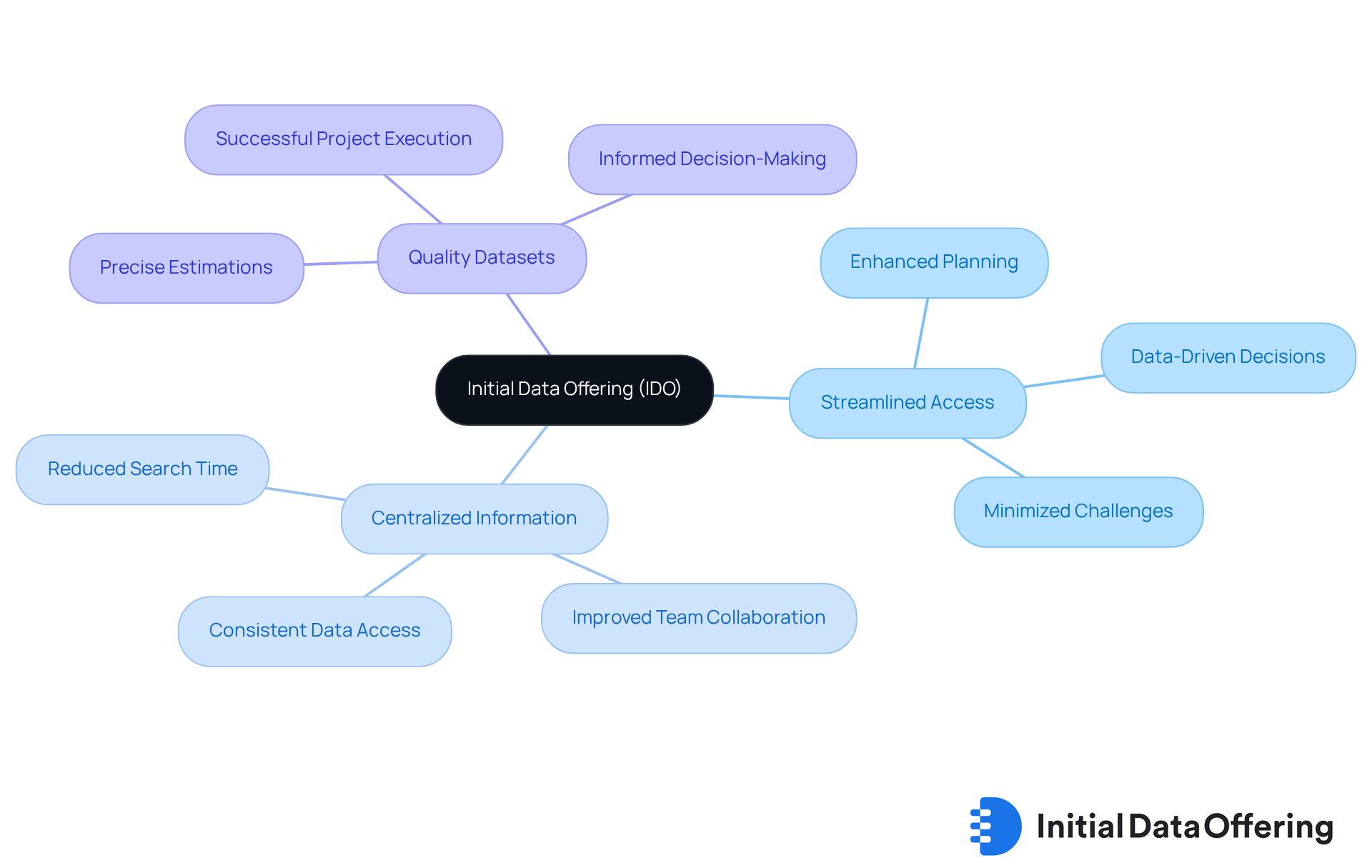
Enhanced Accuracy: Reduce Estimation Errors with AI Technology
AI construction estimating software significantly enhances the precision of construction estimating by utilizing advanced algorithms that analyze both historical data and current specifics. This feature allows AI to recognize patterns and predict costs with remarkable accuracy, minimizing the risk of estimation errors. The advantage of this capability is particularly evident in complex tasks, where traditional manual calculations might overlook essential details. For example, AI estimates for straightforward floorplans typically fall within 5% of human-generated figures, while more challenging projects, like custom staircases, can result in cost variances of 12-15%.
Moreover, AI streamlines bid preparation timelines, reducing them from a week to just days or even hours. This benefit enables contractors to produce preliminary estimates quickly, enhancing overall forecasts and reliability. As the construction sector faces a labor shortage of nearly 500,000 workers, the use of AI construction estimating software not only boosts efficiency but also improves the accuracy of bids.
How can your team leverage AI to stay competitive in this challenging market? As noted by Priyanka Joy, "AI helps them prepare bids faster, reduce costly mistakes, and stay competitive in a market where every hour and every percentage point of accuracy matters.
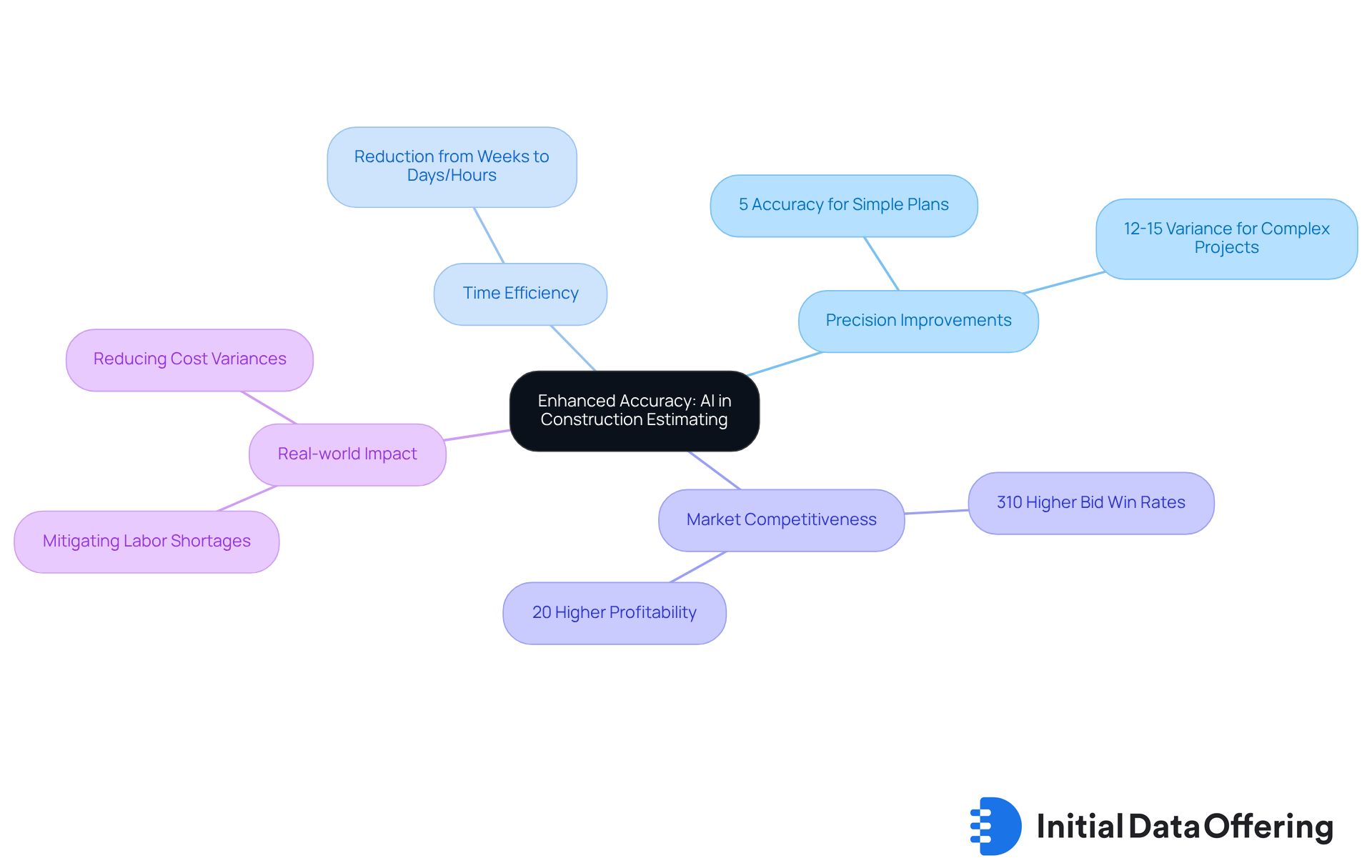
Time Efficiency: Accelerate Project Estimation Processes
AI construction estimating software significantly accelerates assessment processes by automating repetitive tasks and enhancing workflows. This technology allows analysts to generate estimates in a fraction of the time required by traditional methods, leading to quicker responses to bids. As a result, construction companies can improve efficiency and manage more tasks simultaneously, ultimately increasing potential income.
Statistics reveal that:
- 63% of project managers have noticed improvements in project timelines and resource utilization due to AI integration.
- 84% of individuals have experienced enhanced project efficiency after incorporating AI into their processes.
Tools like Beam's AI construction estimating software exemplify how automation can revolutionize estimating workflows, allowing for real-time monitoring of costs and minimizing the risk of overruns. Beam effectively integrates estimates, billing, and payments, fostering growth by increasing bid wins and profits.
By leveraging AI, companies not only boost efficiency but also position themselves competitively in a rapidly evolving market. Have you considered how AI could transform your estimating processes? As highlighted by the Boston Consulting Group, the potential for automation in construction is substantial, with forecasts suggesting that up to 30% of building work could be automated by 2025. This presents a significant opportunity for companies willing to embrace these advancements.
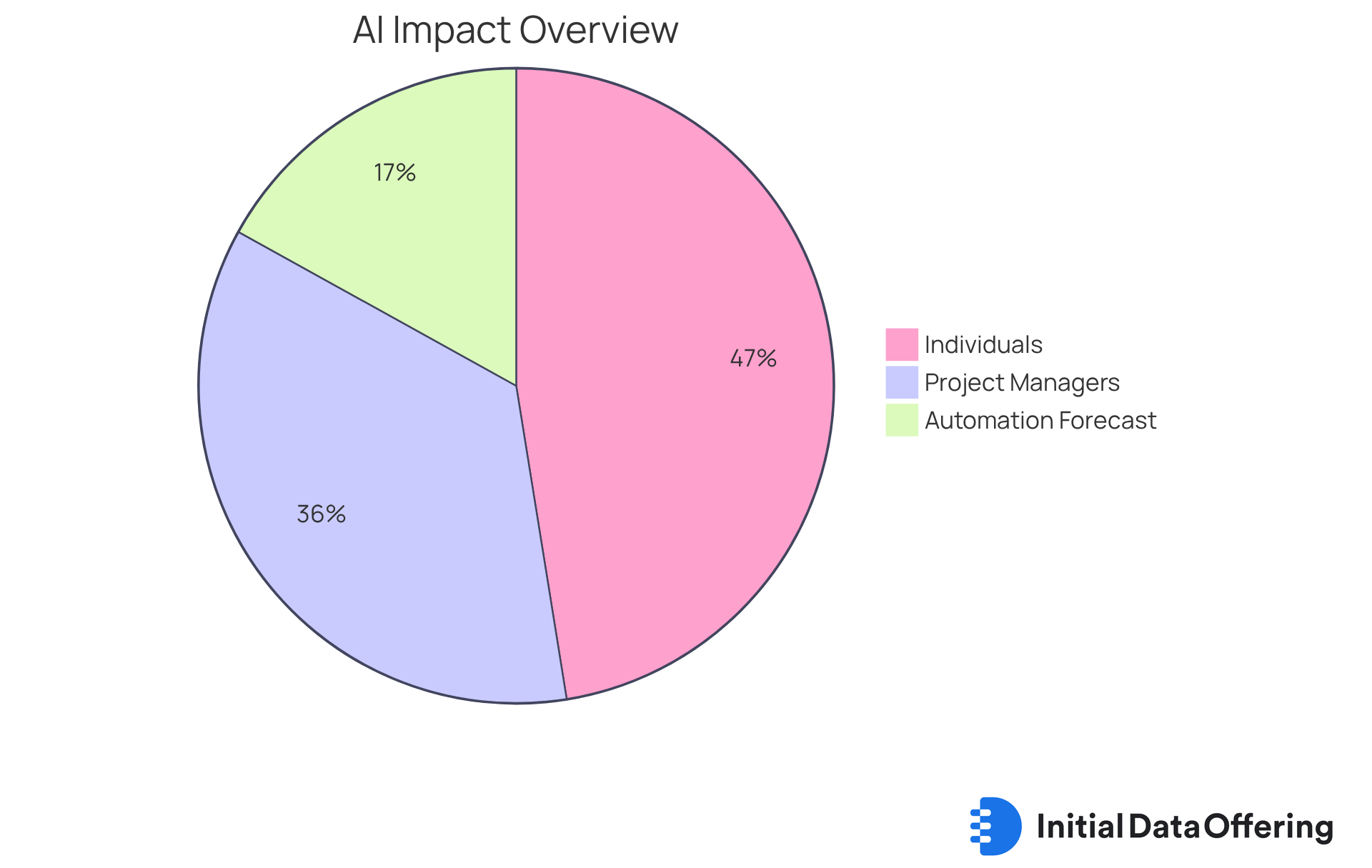
Cost Reduction: Lower Project Costs through AI Insights
AI insights empower construction companies to uncover significant cost-saving opportunities throughout the lifecycle of their projects. By analyzing historical data, AI can accurately forecast potential budget overruns and suggest strategic adjustments in resource allocation. This proactive approach not only reduces overall expenses but also boosts profitability by enhancing budget adherence.
What if you could reduce your budgets and timeline deviations by 10-20%? AI technologies have the potential to achieve just that, along with cutting engineering hours by 10-30%. This allows firms to maintain tighter control over their financial resources. Moreover, AI tools can pinpoint inefficiencies in project management, such as excess labor hours or material waste, leading to more informed decision-making. For example, AI agents monitor equipment utilization to prevent costly downtime, and AI systems have demonstrated 85% accuracy in productivity measurement.
As a result, construction firms leveraging AI are not only improving their financial performance but also positioning themselves for sustainable growth in a competitive market. To fully harness these insights, market research analysts should consider exploring AI construction estimating software like CostOS, which showcases the transformative power of AI in revolutionizing cost estimation.
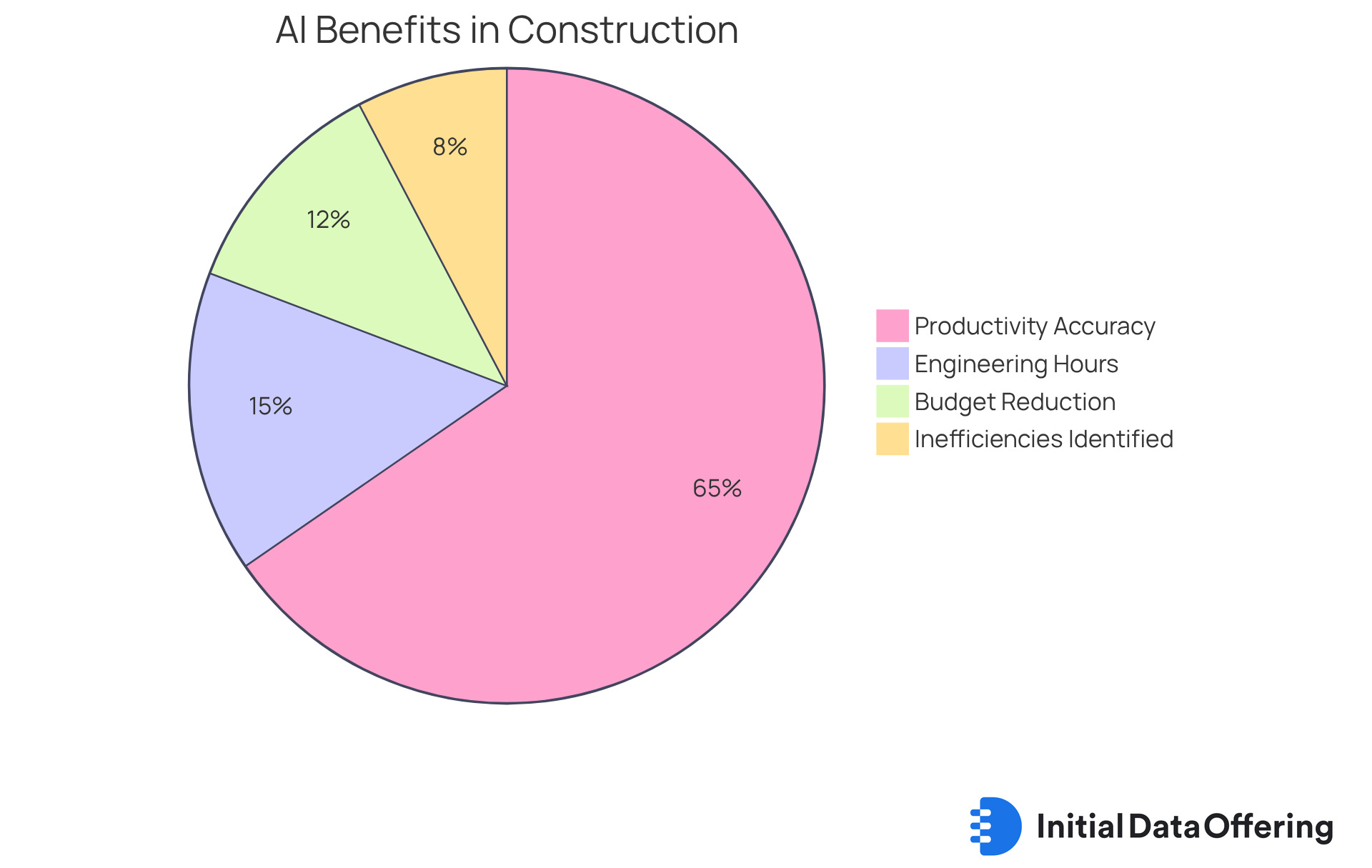
Improved Collaboration: Foster Teamwork with Integrated AI Tools
Integrated AI tools significantly enhance collaboration among construction teams by offering a centralized platform for communication and data sharing. What if your team could access real-time information about their work, share updates, and coordinate tasks more effectively? These tools enable just that, fostering improved collaboration that encourages better alignment on objectives. This alignment decreases the chances of miscommunication and aids in smoother execution.
For instance, AI-driven dashboards merge data from multiple sources, allowing managers to monitor progress and resource utilization in real-time. This capability is essential for upholding timelines and budgets. Specialists in building management emphasize that utilizing AI not only simplifies communication but also improves overall quality and client satisfaction.
As AI tools continue to advance, their capacity to enable smooth collaboration will be crucial in tackling the challenges of contemporary building endeavors. Ultimately, this leads to enhanced productivity and lower expenses. How can your team leverage these tools to improve project outcomes?
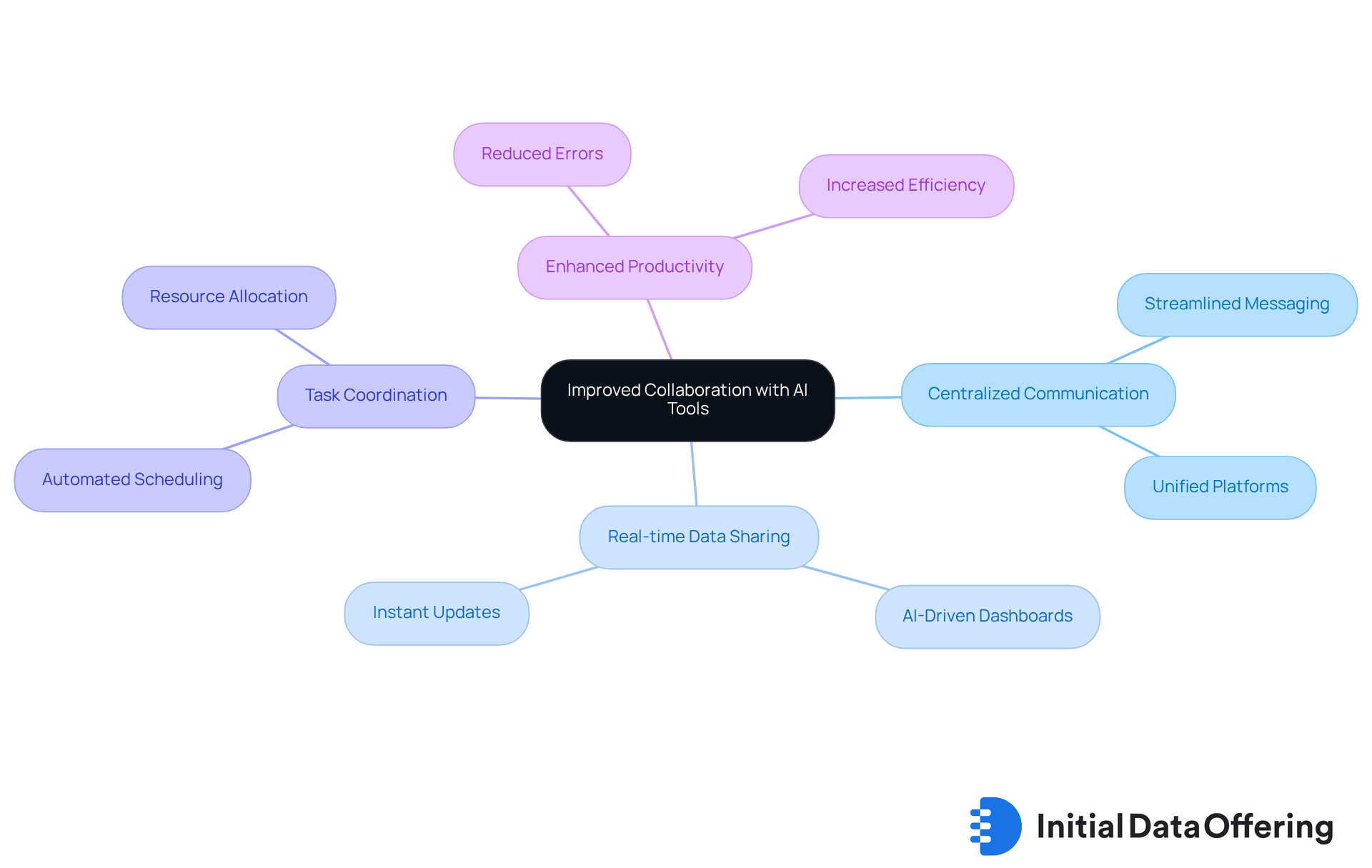
Versatility: Tailor Estimating Solutions for Different Project Types
AI construction estimating software provides remarkable adaptability, allowing users to customize solutions for various projects, including residential, commercial, and industrial endeavors. This adaptability is crucial, as it allows construction companies to address the unique needs and challenges of each project, resulting in more precise estimates. For example, tailored estimating solutions can significantly enhance bidding strategies, thereby increasing the chances of winning contracts.
Statistics reveal that 77% of successful initiatives utilize management software, underscoring the importance of customization in achieving high success rates. By leveraging AI-driven insights, companies can refine their proposals to meet the specific requirements of each sector, ultimately improving overall outcomes. Additionally, AI's ability to perform 'what-if' analyses empowers estimators to quickly adjust inputs, further refining estimates based on project type.
To fully harness the benefits of AI construction estimating software, construction firms should evaluate their specific project needs and choose solutions that align with those requirements. How can your company leverage these insights to enhance your estimating processes? By considering these factors, you can position your business for greater success in a competitive landscape.

Data-Driven Decisions: Leverage AI for Informed Project Choices
Using ai construction estimating software for information-driven decisions empowers construction analysts to make informed choices based on thorough analysis. By leveraging historical data, market trends, and specific task details, ai construction estimating software delivers actionable insights that significantly enhance the planning and execution process. This data-centric approach minimizes reliance on intuition, resulting in improved accuracy in forecasting and resource allocation.
For instance, predictive analytics can decrease task overruns by as much as 30%, while AI systems achieve up to 85% accuracy in real-time productivity assessments. Companies that harness AI-driven insights report a 24% improvement in margin accuracy, demonstrating the tangible benefits of integrating advanced technologies into decision-making processes.
As the construction sector increasingly adopts AI solutions, such as ai construction estimating software, with 45% of companies already utilizing basic analytics, the ability to analyze vast amounts of information will continue to transform management practices. This ensures that decisions are not only timely but also strategically sound. Have you considered how flawed information can lead to costly forecasting errors? Initiatives that rely on insufficient data may experience a staggering 65% increase in budget overruns, underscoring the critical need for high-quality information in predictive analytics.

Real-Time Data Integration: Stay Updated with Current Market Trends
Incorporating real-time information is essential for construction companies aiming to stay attuned to current market trends and developments. What if you could enhance your estimating processes with the most up-to-date details? By utilizing real-time information, analysts can refine their strategies, ensuring that bids remain competitive and aligned with existing market conditions. This capability significantly boosts responsiveness and agility in management, enabling companies to swiftly adapt to industry changes.
Statistics indicate that construction firms employing real-time information experience a marked improvement in their ability to adjust project schedules and procurement tactics. This adaptability helps reduce unforeseen interruptions and budget overruns. For example, the global building estimating software market is projected to grow at a compound annual growth rate of 10.2% from 2025 to 2030, highlighting the increasing reliance on advanced tools.
As the construction landscape evolves, the adoption of AI construction estimating software for data integration becomes crucial for maintaining a competitive edge. How can AI improve your financial planning and scheduling? According to industry specialists, leveraging AI construction estimating software can enhance precision in these areas, further underscoring the necessity for construction companies to embrace these technologies. By doing so, they not only improve their operational efficiency but also position themselves favorably in a rapidly changing market.
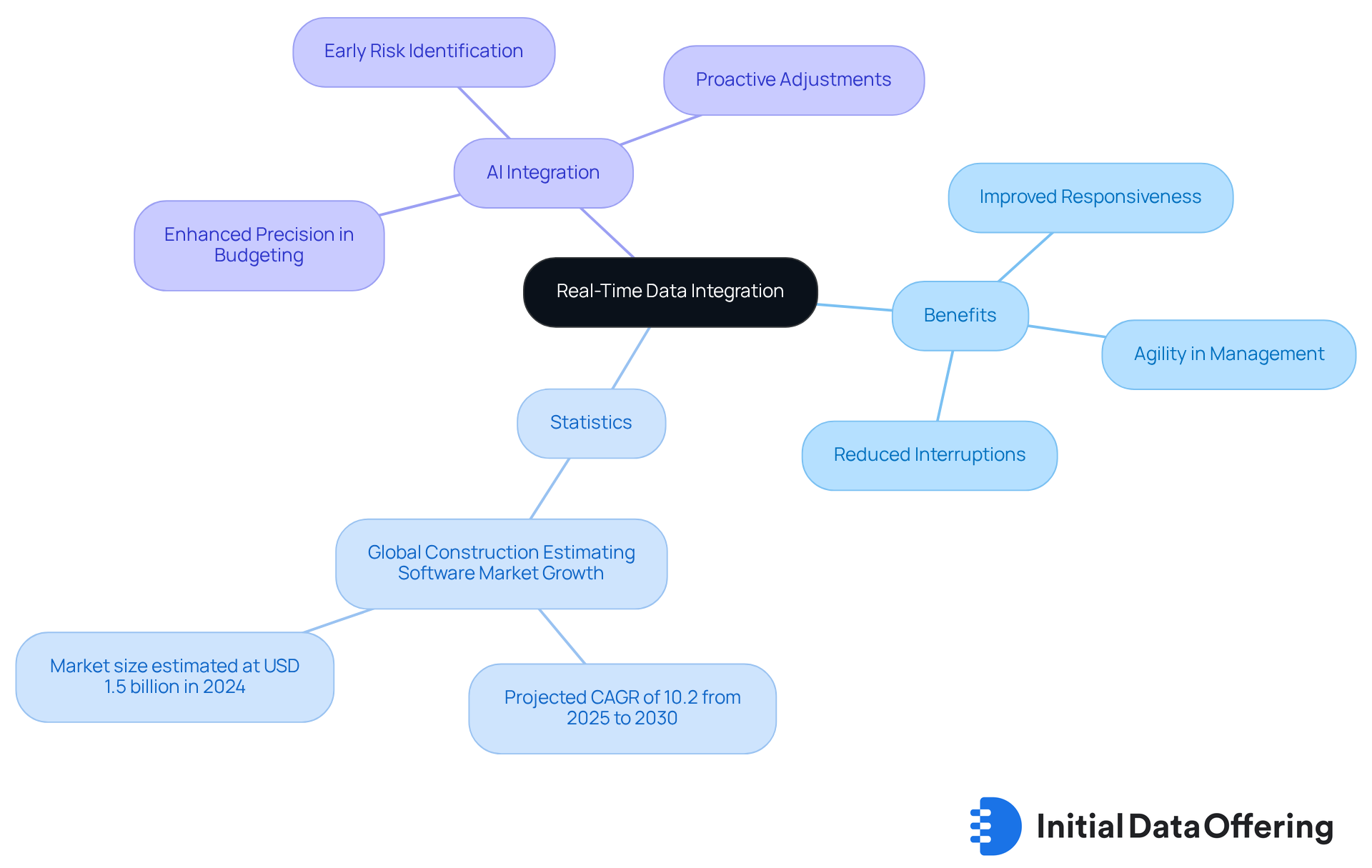
User-Friendly Interface: Simplify Estimation for All Team Members
User-friendly interfaces in AI estimating software offer a significant advantage by simplifying the estimation process for all team members, regardless of their technical expertise. These tools feature intuitive navigation and clear functionalities, enabling users to quickly learn and effectively utilize the software. For example, studies show that teams using such user-friendly software can reduce training time by up to 40%. This allows them to concentrate on their core tasks instead of struggling with complex operations.
The accessibility of these tools not only boosts individual productivity but also enhances collaboration among team members. They can easily share insights and work together without the barriers that intricate software often imposes. Experts in software usability stress that simplifying estimation processes is vital for maximizing team efficiency. They assert, "the best tools are those that empower users to engage fully without the frustration of steep learning curves."
By prioritizing intuitive design, AI estimating software ensures that all team members can contribute effectively. This drives better project outcomes, making it essential for organizations to consider how such tools can enhance their workflows. How might your team benefit from adopting user-friendly estimating software?
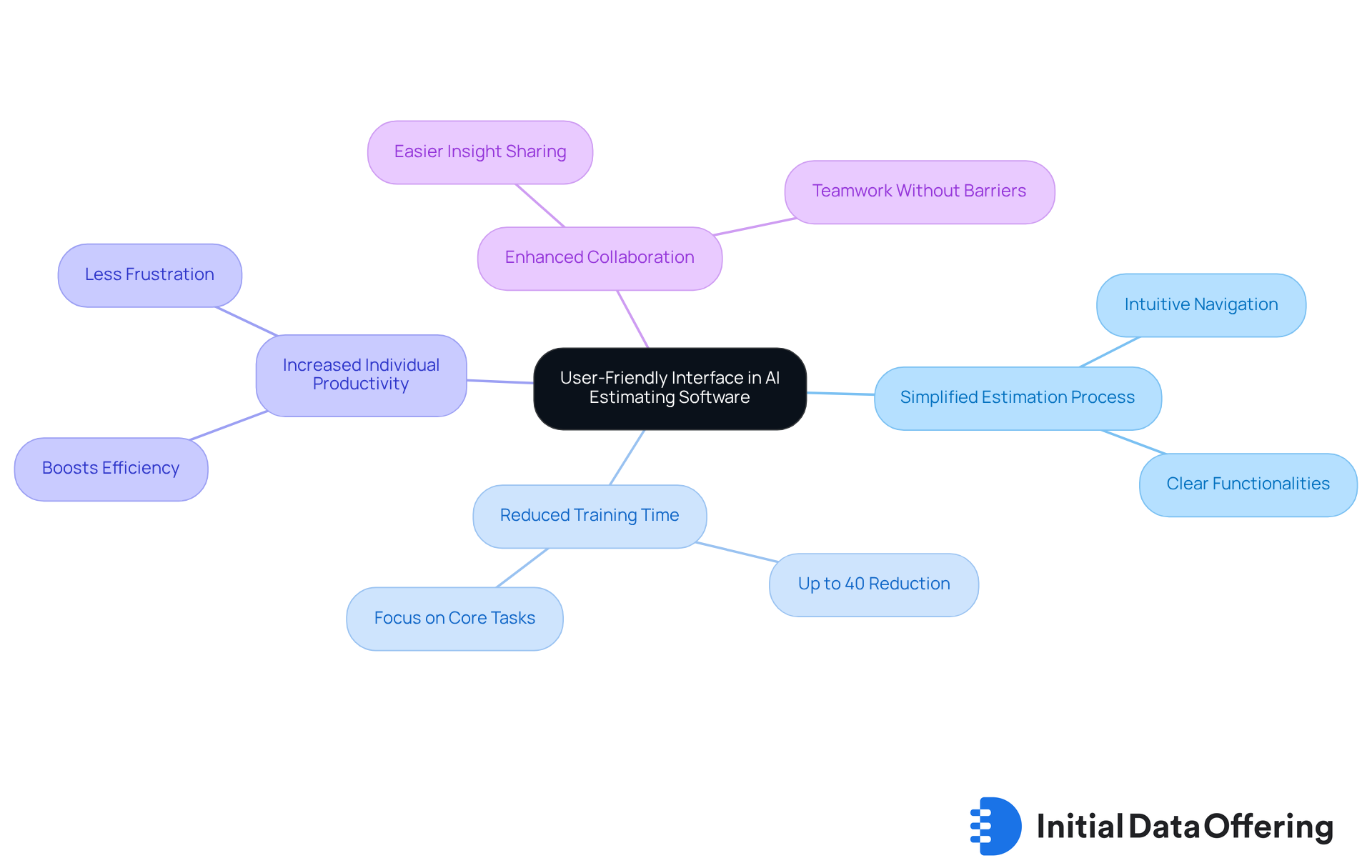
Competitive Edge: Gain Advantage with Advanced Estimating Solutions
Adopting AI construction estimating software offers construction companies a significant competitive edge in the market. These tools not only enhance accuracy but also reduce estimation time and improve collaboration. As a result, companies can submit more competitive bids. In an industry where accuracy and speed are crucial, leveraging advanced technology positions firms as leaders, capable of delivering projects on time and within budget.
Currently, the building sector faces a substantial labor deficit, with nearly 500,000 workers needed. This reality makes the implementation of AI construction estimating software even more critical. Tools like BidScreen XL and Autodesk Takeoff exemplify how technology can streamline estimating processes and enhance bid quality. As Jeff Gerardi, General Manager of Preconstruction Technology at Autodesk, states, 'AI construction estimating software and automation are a powerful combination that can help teams calculate costs, capture the right quantities, and ultimately assist estimating teams in creating winning bids.'
As the construction landscape evolves, leveraging advanced technology not only addresses labor challenges but also positions firms as industry leaders. This strategic approach enables companies to maintain a strong market presence. How can your organization harness these AI solutions to improve efficiency and competitiveness? By embracing these innovations, construction companies can navigate the current labor challenges and thrive in a rapidly changing environment.

Conclusion
The integration of AI construction estimating software offers a significant opportunity for the construction industry, fundamentally changing how analysts approach project estimation. By leveraging advanced technologies, companies can enhance accuracy, efficiency, and collaboration, ultimately leading to improved project outcomes and increased profitability.
Key benefits emerge from this exploration, including:
- Streamlined access to quality data through Initial Data Offerings
- Enhanced accuracy in cost predictions
- Accelerated project timelines
This software not only reduces estimation errors but also fosters collaboration among teams. It allows for real-time data integration and features user-friendly interfaces that empower all team members. Moreover, the adaptability of AI solutions ensures they can be tailored to meet the diverse needs of various project types, making them invaluable assets in a competitive market.
As the construction landscape evolves, embracing AI-driven solutions is essential for firms aiming to maintain a competitive edge. By harnessing the power of AI, organizations can effectively navigate challenges such as labor shortages and market fluctuations while enhancing their operational capabilities. The time to act is now; investing in AI construction estimating software can pave the way for future success and sustainability in an increasingly complex industry.
Frequently Asked Questions
What is the Initial Data Offering (IDO) and its purpose in the construction sector?
The IDO is a resource that provides streamlined access to high-quality datasets, enhancing planning and estimation processes for analysts using AI construction estimating software. It curates unique datasets across construction, finance, and environmental studies, enabling informed, data-driven decisions.
How does the IDO improve efficiency for analysts?
The IDO serves as a centralized hub for information, reducing the time analysts spend searching for trustworthy data. This allows them to focus on their primary responsibilities, facilitating smarter planning and minimizing unforeseen challenges during projects.
Why is high-quality data important for building planning?
Quality information is essential for effective building planning as it leads to precise estimations through AI construction estimating software, ensuring successful project execution and better decision-making.
How does AI construction estimating software enhance accuracy in project estimation?
AI construction estimating software uses advanced algorithms to analyze historical data and current specifics, recognizing patterns and predicting costs with remarkable accuracy. This minimizes estimation errors, especially in complex tasks.
What are the benefits of using AI in bid preparation timelines?
AI reduces bid preparation timelines from a week to just days or even hours, allowing contractors to produce preliminary estimates quickly, enhancing overall forecasts and reliability.
How does AI technology address the labor shortage in the construction sector?
With a labor shortage of nearly 500,000 workers, AI construction estimating software boosts efficiency and improves the accuracy of bids, helping teams stay competitive in the market.
What impact does AI have on project estimation processes?
AI accelerates assessment processes by automating repetitive tasks and enhancing workflows, allowing analysts to generate estimates much faster than traditional methods, which leads to quicker responses to bids.
What statistics support the effectiveness of AI in project management?
Statistics indicate that 63% of project managers have seen improvements in project timelines and resource utilization due to AI integration, while 84% have experienced enhanced project efficiency after incorporating AI into their processes.
How does Beam's AI construction estimating software contribute to project management?
Beam's software automates estimating workflows, allowing for real-time monitoring of costs and minimizing the risk of overruns. It integrates estimates, billing, and payments, fostering growth by increasing bid wins and profits.
What is the potential for automation in the construction industry?
The Boston Consulting Group forecasts that up to 30% of building work could be automated by 2025, presenting significant opportunities for companies willing to embrace AI advancements.